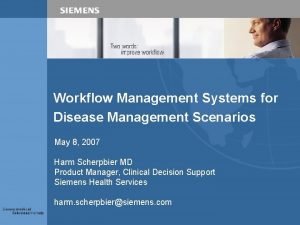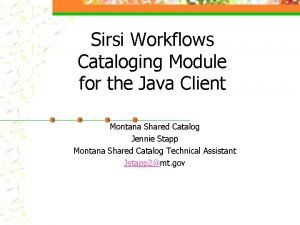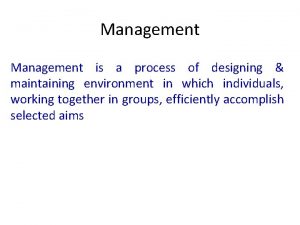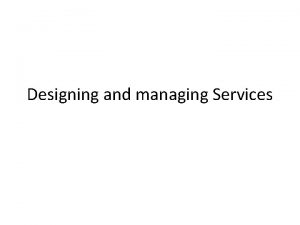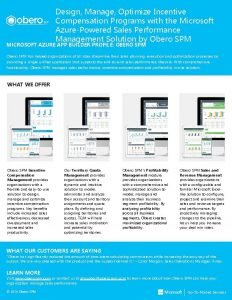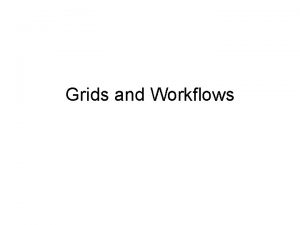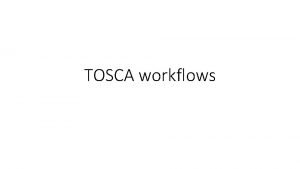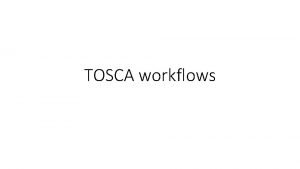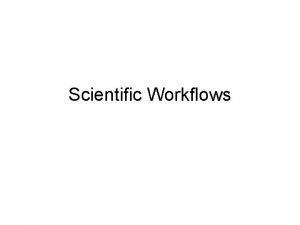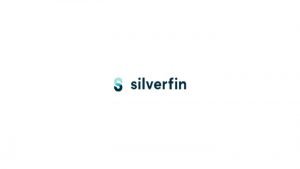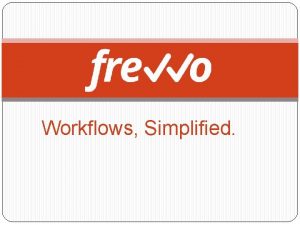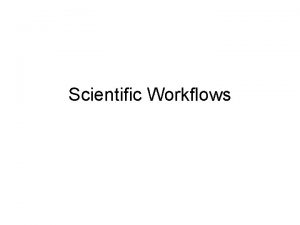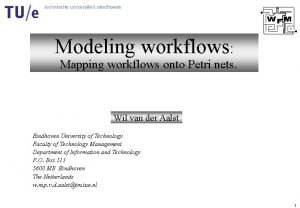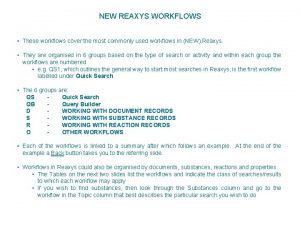An Introduction to Designing and Executing Workflows with



























- Slides: 27

An Introduction to Designing and Executing Workflows with Taverna Aleksandra Pawlik materials by: Katy Wolstencroft University of Manchester

Workflows in Taverna This tutorial will give you a basic introduction to designing, and reusing workflows in Taverna and some of its main features. Workflows in this practical use small data-sets and are designed to run in a few minutes. In the real world, you would be using larger data sets and workflows would typically run for longer

Taverna: Download and installation Taverna can be downloaded from http: //www. taverna. org. uk/ Go to the page and find the latest (2. 4) Follow the instructions on the website to install Taverna for your operating system (this is a simple one-click install for windows and Mac. For Linux, you may also need the Graph. Viz program. Follow the link on the Taverna download page if so) The following page shows a screenshot of Taverna and the different panels that make up the workbench

Taverna Workbench Services Panel Workflow Explorer Workflow Diagram

Workflow Diagram The workflow diagram is the visual representation of the workflow, it: Shows inputs, outputs, services and data flows Allows editing of the workflow by dragging and dropping and connecting services together Enables saving of workflow diagrams for publishing and sharing

Workflow Diagram

Workflow Explorer The Workflow Explorer shows the detailed view of your workflow. It shows default values and descriptions for service inputs and outputs and it shows where remote services are located. It also shows configuration details, such as iteration and looping Workflow validation details can also be found here. Before a workflow is run, Taverna checks to see if it is connected correctly and if its services are available.

Updates and Plugin Installation Taverna updates are issued on the regular basis There is also a number of plugins which are developed for Taverna To get the updates and plugins select “Advanced -> Updates and plugins”

Available Services Panel Lists services available by default in Taverna Local java services WSDL Web Service – secure and public RESTful Services R Processor services (for statistical analyses) Beanshell scripts Xpath scripts Spreadsheet import service The services panel also allows you to add new services or workflows from the web or from file systems – there are loads more available!

Exercise 1: Building a Simple Workflow We will start with something easy - retrieving a protein sequence from a remote database and identifying functional motifs Go to the Services Panel Type ‘Fasta’ into the ‘search’ box at the top of the panel You will see several services in the search results � Select ‘Get Protein FASTA’ and drag-and-drop it into the workflow diagram panel.

Exercise 1: Building a Simple Workflow In a blank space in the workflow diagram, right-click and select “Workflow input port” from the “Insert” section Type in a name for this input (e. g. ID) and click “ok” Do the same to create a new workflow output. Call this output “sequence”

Exercise 1: Building a Simple Workflow You now have 3 boxes in the diagram and we need to connect them up Click on the input box and drag towards “Get Protein Fasta” and let go. An arrow will connect the two boxes

Exercise 1: Building a Simple Workflow Click on the output box, drag towards “Get protein fasta”, and let go. An arrow will connect the two boxes You have now built your first workflow! It should look something like this

Exercise 1: Building a Simple Workflow Run the workflow by selecting “file -> run workflow”, or by clicking on the play button at the top of the workbench

Exercise 1: Building a Simple Workflow An input window will appear. As you can see, we have not yet added a description of the workflow or of the input Click on ‘Set Value’ in the input window and add a Uniprotein identifier (e. g. P 15409) where it says “some input data goes here”

Exercise 1: Building a Simple Workflow Click “run workflow” In the bottom left of the results window, click on the results. You will now see a protein sequence from Uniprot Now we will find out what functional motifs the protein contains, but first we have to tell Taverna about some new services

Validate your Workflow Taverna can check to see that everything is connected properly and that all the services in your workflow are available Go to the workflow explorer and click on ‘validation report’ See if Taverna has found any problems with the workflow. Errors will be displayed in red, warnings in yellow. Workflows with warnings often still run. If there are problems, follow the instructions to resolve them by clicking on the ‘Solution’ tab

Exercise 2: Adding more Services We can connect the two services together in the same way as before At the top of the workflow diagram panel, change the view to show all ports by clicking on the icon shown below Show all ports icon This view allows you to see any data input/output or parameter value options for your chosen service

Exercise 2: Adding more Services q q q Most of the time, you don’t need to connect all ports. Some are optional and some already have default values set. Service documentation should tell you this. You can use the Bio. Catalogue to find documentation and user descriptions Change the orientation of the port names to fit them on the screen more easily by clicking on the icon shown below change orientation

Adding a Workflow Description Right-click on a blank part of the workflow diagram and select “Annotate” Add some details about the workflow e. g. who is the author, what does it do You can also add examples and descriptions for the workflow inputs by selecting them and selecting “Annotate” Add an example for the protein ID (e. g. P 15409) Save the workflow by going to “File -> save workflow” Run the workflow again and look at the results

Exercise 2: Using REST Services Taverna can also run WSDL and RESTful services Go to the Service Catalogue tab of Taverna and search for dbfetch From the REST Service results, select GET /dbfetch/{db}/{id} Right-click on the service and select “Add to Service Panel”

Exercise 2: Using REST Services Searching the service catalogue

Exercise 2 a: Using REST Services In the services search panel in Taverna, search for dbfetch Right-click on the service and choose “Add to workflow with name…” Enter a name such as “dbfetch” and click OK

Exercise 2 a: Using REST Services As you can see, the items from the dbfetch template become inputs in Taverna.

Exercise 2 a: Using REST Services You can also enter the template directly Right-click on an empty area of the workflow and select “REST” from the “Insert” section Enter the template and click OK

Exercise 2 a: Using REST Services For this service, we need to supply a database name and a protein ID. Connect the protein ID input to the REST service ID input port Right-click on the ‘db’ input port on the REST service and select ‘constant value’. Add the constant value ‘uniprotkb’ and click “OK” Add a workflow output port and connect it to the REST ‘response body’ output port Your workflow should look something like the on the next slide Save and run your workflow Now your results will include the uniprot entry for your protein

Exercise 2: Using REST Services
 Disease-specific workflows
Disease-specific workflows Jira default workflow diagram
Jira default workflow diagram Ivar nnn
Ivar nnn Goanywhere advanced workflows
Goanywhere advanced workflows Walker royce software project management
Walker royce software project management Sirsi workflows
Sirsi workflows Crafting and executing strategy in strategic management
Crafting and executing strategy in strategic management Type of plating arrangement
Type of plating arrangement What is the zone control system in driving
What is the zone control system in driving Designing and delivering oral and online presentation
Designing and delivering oral and online presentation The art and science of designing and constructing building
The art and science of designing and constructing building The process of designing and maintaining an environment
The process of designing and maintaining an environment Computer design embroidery
Computer design embroidery Designing pay levels mix and pay structures
Designing pay levels mix and pay structures Steps in designing hrd programs
Steps in designing hrd programs Service marketing triangle of pizza hut
Service marketing triangle of pizza hut Managing products and brands
Managing products and brands Product and service design
Product and service design Fleishman job analysis system
Fleishman job analysis system Designing and managing services
Designing and managing services Designing and managing services kotler keller ppt
Designing and managing services kotler keller ppt Dialogue sequence diagram
Dialogue sequence diagram Toyota brand hierarchy
Toyota brand hierarchy Designing and implementing branding strategies
Designing and implementing branding strategies Designing and managing integrated marketing communication
Designing and managing integrated marketing communication Test of details of balances examples
Test of details of balances examples Textbook development process
Textbook development process Designing and managing incentive compensation programs
Designing and managing incentive compensation programs
